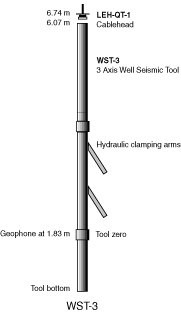3-Component Well Seismic Tool (WST-3*)
Description
 The WST-3 was a Schlumberger three axis check shot tool for both zero offset (chef shot) and offset vertical seismic profiles (VSP). It consisted of three geophones that pressed against the borehole wall and recorded the acoustic waves generated by an air gun located near the sea surface. The tool was designed specifically for use in an offset VSP experiment, where a remote seismic source would be fired from a second ship.
The WST-3 was a Schlumberger three axis check shot tool for both zero offset (chef shot) and offset vertical seismic profiles (VSP). It consisted of three geophones that pressed against the borehole wall and recorded the acoustic waves generated by an air gun located near the sea surface. The tool was designed specifically for use in an offset VSP experiment, where a remote seismic source would be fired from a second ship.
The WST-3 was used on several ODP legs in 2002 and 2003 and on IODP expedition 305.
Applications
Offset VSP data acquired by the WST-3 are useful for:
- Providing seismic interval velocities which can be compared to the rock sequence intersected by the borehole
- Placing the borehole results in their proper setting with respect to the seismically defined structure of the oceanic crust and mantle
- Correlating borehole lithology with the up-going seismic reflected wavefield
- Predicting structure and lithology changes below the drill hole
- Estimating physical properties of rock on seismic scales by studying particle motion and downhole seismic attenuation. In check shot mode, the WST-3 data can be used to produce a depth-travel time tie and to calibrate the sonic logs and determine accurate drilling depths and their relative position with respect to targets on the seismic reflection profiles.
Tool Specifications
Mechanical:
| Temperature rating: | 350° F (175° C) |
| Pressure rating: | 20 kpsi (138 MPa) |
| Diameter: | 3.625 in (9.21 cm) |
| Length: | 19.9 ft (6.07 m) |
| Weight: | 310 lbs (141 kg) |
| Sampling interval: | 1, 2 or 4 msec (selectable) |
| Minimum hole diameter: | 5 in (12.7 cm) with “short” arms |
| Maximum hole diameter: | 19 in (48.3 cm) with “long” arms |
| Maximum logging speed: | Stationary |
Sensors:
| Axis: | 3 axis |
| Geophone: | 3 axis |
| Geophone type: | SM4 (3ea gimbaled) |
| Geophone frequency: | 10 Hz |
| Damping: | 60 dB |
| Sensitivity per axis: | 83 V/m/sec or 0.8 V/in/sec at 25° C |
| Low-cut frequency: | 0.2 Hz |
| Low-cut slope: | 18 dB per octave |
| High-cut frequency : | 250 Hz for 1 msec or 125 Hz for 2 and 4 msec sampling |
| High-cut slope: | 36 dB per octave |
| Digitization: | Downhole |
| Sampling rate: | 1, 2 or 4 msec (selectable) |
| ADC resolution: | 11 bit + sign |
| Autoranger steps: | Five 6 dB steps |
| Preamplifier gain: | 40 – 160 dB by 6 dB steps for each axis |
| Dynamic range per waveform (shot): | 90 dB |
| Total dynamic range: | 156 dB |
| Input noise level: | 2 μV |
| Anti-aliasing filters: | 330 Hz / 24 dB per octave |
Deployment Notes
The WST-3 could be used in both checkshot and offset vertical seismic profile experiments. A remote seismic source was required for an offset survey, while a traditional check shot survey could be completed with existing equipment on the JOIDES Resolution. For each type of experiment, the deployment routine for the WST-3 was approximately the same. The main difference was simply the location of the source and the handling of the trigger pulse. For a check shot, a 120 in³ air gun was suspended by buoys at a depth of 3 mbsl, offset 48.5 m from the hole on the portside. The WST-3 was clamped against the borehole wall at intervals of approximately 50m, and the air gun fired five to seven times. The resulting waveforms were stacked and a travel time was determined from the median of the first breaks in each trace. These check shot experiments attempted to reproduce the seismic reflection profiling by simulating a similar geometry and source frequency.
The WST-3 was always the last tool run and was always run alone. At each selected station, a seismic shot was produced at the sea surface using either air or water guns. Schlumberger provided a blast hydrophone for synchronizing the gun pulse with the system timer.
The WST-3 was sensitive to pipe noise and ringing of pipe following a shot. Efforts were made to reduce pipe noise at each station. If time and resources permitted, a drill string packer was deployed to dampen the banging motion of the pipe against the borehole. In addition, a 50 to 75 m distance was left between the tool and the bottom of pipe.
The WST-3 was powered with a 400 Hz power supply. The CSES was not used with the WST-3 for three primary reasons:
- If the bottom of pipe was near the tool, it was likely that the tool would measure ringing in the pipe each time the gun was fired.
- If a significant amount of pipe was downhole, there was the possibility that the pipe could generate a noise in the data as the pipe banged in the hole.
- The WST-3 was an inherently risky tool to deploy because the tool was held in a stationary position in a deteriorating borehole. Use of the CSES could only exacerbate these risks by providing access to a hole that might be unsafe for the WST-3.
* ®trademark of Schlumberger
